Sum one account
Use the “support” tab to send us direct support requests through our contact form.
Real forex bonuses
This allows us to gather information faster and in turn, we can help you quicker. In the third section, you can access the tabs profile, refer a friend, shop and support.
My sumup profile
When you open your online profile there are three different menu sections on the left side. Please have a look at the different sections to find out more about what you can do via sumup.Me .
Sales & payouts
In the first section, you can find information on your sales and payouts.
In the "sales" tab, you can find a list of all your transactions that you have processed through sumup. We also offer a variety of business and tax-relevant reports for you to download. Additionally, you can refund transactions here.
The "payouts" tab allows you to check the details of your payouts. You can filter for individual payouts and immediately download the payout report. By clicking on an individual payout you’ll be able to see every card payment that is included in that payout.
My sumup products
In the second section, you’ll find an overview of our additional sumup software products. To find out more about each of them, have a look at these articles: my products, sumup card, online store, invoices.
My profile & more
In the third section, you can access the tabs profile, refer a friend, shop and support.
Access the "profile" tab to check and change your personal or business details, and to manage your employees, your privacy and payout settings. Moreover, the developers page offers our integration partners information about our products and integrations. It helps you build payment accepting solutions for your business.
Click “refer a friend” and earn a reward by simply sharing your link via facebook, twitter or any other app. For more information, have a look at these frequently asked questions.
Just click “shop” in the menu and order additional card readers or accessory hassle-free.
Use the “support” tab to send us direct support requests through our contact form. This allows us to gather information faster and in turn, we can help you quicker.
Was this article helpful?
Thanks for letting us know!
Thanks for letting us know!
We've got a very short survey about the support centre that we'd really appreciate you filling out so that we can make it even better. Take the survey
One account
Getting higher interest rates doesn't have to be a challenge
The UOB one account is still the simpler way to earn higher interest rates.
More reasons to save this new year
Usher in 2021 with prosperity and abundance with up to S$168 sure-win hongbao 8 when you save with UOB! Plus, be one of 10 lucky winners to walk away with 10X (up to S$1,680 8 ) your sure-win hongbao amount at our grand spring hongbao draw!
+# when you open a new account online!
Credit your salary for additional bonus interest
For a limited time only, you can now earn bonus interest of up to 2.75% p.A. 10 (additional interest of 0.25% p.A. 7 ) on your savings when you credit your salary.
Announcement: with effect from 1 february 2021, please be informed that transactions involving payments to hospitals, automobile parking lots and garages will be excluded from the list of monthly qualifying spend for the UOB one card, one debit card and the awarding of bonus interest on the UOB one account. For details, visit here for the UOB one card T&cs, here for UOB one debit T&cs and here for the UOB one account T&cs.
How it works
Earn higher interest rates of up to 2.50% p.A. 1 on your savings with UOB one account.
Plus, for a limited period only, earn additional interest of 0.25% p.A. 7 on your savings when you credit salary of at least S$2,000 into your UOB one account. This means that you’ll get to earn up to 2.75% p.A. 10 on your savings!
Spending on eligible UOB credit/debit card
To earn first tier interest rate of 0.25%
Crediting your salary into your UOB one account
And earn higher
interest of up to 2.75% p.A. PROMOTION!
Making GIRO debit transaction from your UOB one account
To earn higher interest on your savings
Make a minimum of S$500 eligible card spend^ on eligible UOB credit card or UOB debit card to earn bonus interest on the UOB one account.
^ eligible card spend transactions are based on the following
- Eligible visa/mastercard local and foreign retail transactions subjected to the exclusions mentioned below;
- Insurance payments made on a recurring basis on selected credit or debit cards;
- Total posted retail transactions by the selected credit card(s) principal and supplementary holder plus any spending on the selected debit card(s); and
- Transactions posted within a CALENDAR month
UOB credit and debit cards that are eligible to earn bonus interest on the UOB one account include UOB one card, UOB lady’s card + (all card types), UOB YOLO credit card, UOB one debit visa card*, UOB one debit mastercard*, UOB lady’s debit card and UOB mighty FX debit card.
See here for full list of retail transactions.
Apply for UOB one account and UOB lady's card here.
Apply for UOB one account and UOB YOLO here.
Note: A UOB one debit mastercard* will be automatically issued to you if your UOB credit card (UOB one card/UOB lady’s card/UOB YOLO) application is unsuccessful.
+ UOB lady's card refers to any UOB lady's / lady's platinum / lady's solitaire credit and/or lady’s debit cards issued by UOB.
*UOB direct visa debit card & UOB debit mastercard has now been renamed to UOB one debit visa & UOB one debit mastercard respectively.
For a limited time only, earn additional interest of 0.25% p.A. 7 , over and above the interest which may be earned at the prevailing interest rates, on your account’s MAB from 1 march 2021 to 31 august 2021 (“interest earning period”)!
Who is eligible
all new and existing customers who do not have salary credited into any UOB account prior to the campaign (i.E. During the period
1 jul 2020 to 31 dec 2020).
Step 1: register your interest via online participation form below between 4 january 2021 to 28 february 2021 (“participating period”):
Step 2: credit your salary of at least S$2,000 via GIRO into your UOB one account on a monthly basis from 1 march 2021 onwards.
Tip:
to credit your salary credit to the UOB one account, you will need to notify your HR department on your new account number. If applicable, you can use the template we have developed for you to send it to your HR department. Email your HR to make the switch now!
Step 3: you will earn an additional interest of 0.25% p.A. 7 on your account’s MAB for each calendar month (during the interest earning period) with valid salary credit via GIRO (min. S$2,000).
Assuming the customer has no salary credit during the period from 1 jul’20 – 31 dec’20, and submitted the participation form during the participating period to sign up for the UOB salary credit campaign (4 january to 28 february 2021).
Interest earning period (2021)
Met card spend of S$500?
Credited salary of at least S$2000 via GIRO?
Prevailing interest rate on your accounts’ MAB (p.A.)
Eligible for bonus interest of 0.25% under salary credit campaign?
Interest rate you could be enjoying on your account's MAB (p.A.)
7 UOB salary credit campaign (4 january to 28 february 2021) terms and conditions apply.
Eligible salary credit transactions must be:
- Made through GIRO with the transaction description "GIRO-SALA”; and
- Successfully credited within the CALENDAR month
See here for transactions excluded from salary credit transactions.
You need to make a minimum of 3 GIRO debit transactions payable to any billing organisations with the bank. Eligible transactions must be posted within the calendar month.
GIRO transactions are dependent on billing organisations and deduction dates are determined by the billing organisations. For payments that are due at month end or beginning of the month, there is a risk that the deduction will flow to next month or be brought forward.
To facilitate your GIRO instructions, you can follow one of the steps below:
Sign up/in via UOB personal internet banking and go to “apply for” and choose “GIRO arrangement”. You will be able to apply directly with the following billing organisations online:
• geneco seraya energy
• HDB
• IRAS
• pacificlight energy pte ltd
• UOB car financing payment
• UOB credit card centre
note that bonus interest does not apply to mortgage loans and card loans.
For billing organisations that are not found in UOB personal internet banking and require dedicated GIRO forms, please download the forms here:
• prudential
• singtel
• M1
• starhub
• SP services
See here for transactions excluded from GIRO debit transactions
Here’s how it all adds up:
*total interest is equivalent to base interest plus bonus interest; where current base interest is 0.05% p.A. And bonus interest is paid on the first S$75,000 balance in your one account. Base interest is calculated at the end of each day based on each day-end balance and bonus interest is calculated at the end of each calendar month based on the monthly average balance. Monthly average balance is the summation of each day end balance for each month divided by the number of calendar days for that month.
1 maximum effective interest rate (EIR) on the one account is 0.25% p.A. For deposits of S$75,000, provided customers meet the criterion of S$500 card spend in each calendar month. Maximum effective interest rate (EIR) on the one account is 1.00% p.A. For deposits of S$75,000, provided customers meet both criteria of S$500 card spend AND 3 GIRO debit transactions in each calendar month.
Benefits
Up to 10% rebate
When you spend on your UOB one credit card
or the UOB one debit card.
New joint account now available online
Apply for a joint account from the comfort of your home and enjoy an easy and transparent way to manage shared finances.
Enjoy generous rebates on online shopping, groceries, health and beauty, convenience stores, transport, food delivery, petrol and more with the UOB one credit card and the UOB one debit card.
- Up to 10% rebate 2 on shopee singapore, dairy farm singapore, grab and singapore power with UOB one credit card
- Up to 3% rebate 3 on shopee singapore, dairy farm singapore and grab with UOB one debit card
Note: A UOB one debit mastercard* will be automatically issued to you upon successful application of your UOB one account.
- The operating mandate will be joint-OR (either party to sign). Both account holders can access the funds in the account.
- Each customer can only hold 1 one account as primary account holder. Customer who initiated the application will be defaulted as the primary account holder.
- To earn bonus interest, the primary account holder must spend a min of S$500 on his/her eligible card. Spend charged to the card of the secondary account holder will not be considered as eligible card spend to earn bonus interest.
- Transactions made by the secondary account holder will also affect the MAB # .
- All promotions are applicable for the primary account holders only unless otherwise stated.
Note: customer can choose to apply for a joint account in the application by providing the joint applicant details. An email will be generated to the joint applicant to inform him/her that he/she has been nominated by the main applicant. The joint applicant would be required to complete the application within 7 working days.
Who is a primary account holder?
The primary account holder will be the main applicant when the application is submitted. It will be displayed as the first name under the account holder’s name.
For illustration purposes only:
account holder’s name: ms wendy tan &/or ms alice tan
primary account holder: ms wendy tan
secondary account holder: ms alice tan
Link mighty FX to your one account
Get competitive exchange rates for your overseas spend.
Convenience of a monthly estatement
Go paperless with 5 years of stored electronic statements from the time you subscribe
What's more, you can earn higher interest of up to 2.50% p.A. 1 on your savings with UOB one account, when you spend on the mighty FX debit card.
Calculator
Calculate my total savings
Calculate UOB one credit card rebate
Rebate calculator
Promotion
Save with UOB for a prosperous 2021
Usher in the new year with prosperity and abundance with up to S$168 sure-win hongbao 8 when you deposit fresh funds into your UOB one account. Plus, stand to make your year more bountiful if you’re one of 10 lucky winners to walk away with 10X (up to S$1,680 8 ) your sure-win hongbao amount at our grand spring hongbao draw!
Simply SMS to register for the tier you wish to participate in and deposit fresh funds to complete the registration.
Receive a sure-win hongbao 8 from the tier that you have registered for!
Please note that you can only choose to participate in one tier for this promotion.
To register your participation, simply SMS to 77862 in the following format from now till 28 february 2021
Fresh funds amount (i.E. 50K, 100K or 200K) ‹space›10-digit one account number
Example:
if you wish to register for the S$50,000 tier, SMS: 50K 0123456789
if you wish to register for the S$100,000 tier, SMS: 100K 2468013579
if you wish to register for the S$200,000 tier, SMS: 200K 0123456789
The amount of fresh funds indicated in your SMS registration for this promotion and deposited into your UOB one account will be earmarked for approximately 4 months.
Apply now
Don't have a UOB one account yet? Get up to S$230 cash credit when you apply online now!
Action(s)
Reward
Eligibility and fees
| age | 18 years beyond |
| fall-below fee | S$5 min monthly average balance of S$1,000 |
| early account closure fee | S$30 within 6 months from opening |
| cheque book | S$10 per additional cheque book (50 leaves) |
Get up to S$230 when you apply online for both one account 5,6 and one card 4 .
Note: A UOB one debit mastercard will be automatically issued to you if your UOB credit card (UOB one card/UOB lady’s card/UOB YOLO) application is unsuccessful.
Now, you can open and transact with your account instantly. (joint account now available online)
get up to S$80 5,6 when you apply online for UOB one account.
Apply for a new UOB account 24/7 by retrieving your personal information with myinfo. Applications submitted between 8.30am to 9pm (for new UOB customers) will be opened instantly. Applications received outside these times will be processed the next working day.
Actions or documents required
For singaporeans and prs
You can now apply via myinfo, where forms are prefilled with no submission of documents needed. You will require:
Choose to apply for
- Instant account opening for UOB one account or
- UOB one account and one card
Application of UOB one account and one card (via the online form)
- Upload images of NRIC (front and back)
- Authorise the bank to access CPF history
For foreigners and U.S persons
Please proceed to any UOB branch for application. You will require:
- Passport
- Proof of residence address
- Employment pass/ S pass/ dependent pass
2 enjoy up to 5% cash rebate based on a retail spend of S$2,000 and min. 5 transactions per statement month for each qualifying quarter to earn the quarterly cash rebate of S$300. Enjoy up to 3.33% cash rebate based on a retail spend of S$1,000 or S$500 and min. 5 transactions per statement month for each qualifying quarter to earn the quarterly cash rebate of S$100 or S$50 respectively. Cardmembers who have been awarded the quarterly cash rebate will get an additional 5% rebate on the total dairy farm singapore such as cold storage, giant, guardian, 7-eleven, marketplace, jasons, jasons deli, grab (excludes mobile wallet top-ups), shopee singapore (excludes shopee pay) and UOB travel (excludes online and flight only bookings) transactions successfully charged and posted to the card account in each statement month. Cardmembers who have been awarded the quarterly cash rebate will get an additional 1% rebate on the singapore power utilities bill (excluding payments via AXS) successfully charged and posted to the card account in each statement month. Additional rebates will be capped at S$100 per month. Visit uob.Com.Sg/one for full terms and conditions.
3 enjoy 3% rebate on dairy farm singapore ("DFSG") transactions (cold storage, giant, guardian, 7-eleven, marketplace, jasons and jasons deli), 3% rebate on shopee singapore transactions (excludes shopee pay) & 1% rebate on grab transactions (excludes mobile wallet top-ups) with a minimum monthly spend of S$500. Rebates are capped at S$20 per calendar month across all DFSG, shopee singapore & grab transactions. Visit uob.Com.Sg/onedctncs for UOB one debit card terms and conditions.
4 S$150 cash credit: limited to the first 200 new-to-UOB cardmembers to successfully apply for a new UOB credit card from 1 to 28 feb 2021 and spend at least S$1,500 within 30 days from the card approval date. Click here for full terms and conditions.
5 S$80 cash credit (for new-to-UOB deposits customers)
be the first 200 applicants (per month) to:
- Successfully open a new eligible UOB account^ online between 1 jan to 28 feb 2021; and
- Deposit at least S$5,000 of fresh funds into your new UOB account by 28 feb 2021; and
- Maintain the fresh funds deposited into your new UOB account for 6 consecutive months.
Click here for full terms and conditions.
6 S$40 cash credit (for existing UOB deposits customers as at 31 dec 2020)
be the first 200 applicants (per month) to:
- Successfully open a new eligible UOB account^ online between 1 jan to 28 feb 2021; and
- Deposit at least S$5,000 of fresh funds into the new UOB account by 28 feb 2021 which results in a corresponding increase of at least S$5,000 when compared against the total amount standing to the credit of all your other UOB current accounts and/or savings accounts as at 31 dec 2020; and
- Maintain the fresh funds deposited into your new UOB account for 6 consecutive months.
Click here for full terms and conditions.
^ eligible UOB account: UOB uniplus account, UOB stash account, krisflyer UOB account, UOB lady’s savings account and/or UOB one account.
7 S$50 shopee vouchers: limited to the first 250 new-to-UOB one credit card applicants per calendar month who successfully apply for a new UOB one credit card from 1 nov to 31 dec 2020 and spend at least S$1,500 within 30 days from the card approval date. Click here for full terms and conditions.
8 S$20 shopee vouchers: limited to the first 400 new-to-UOB one debit visa card and first 400 new-to-UOB one debit mastercard applicants per calendar month who successfully apply for a new UOB one debit visa card or one debit mastercard respectively from 1 nov to 31 dec 2020 and make at least 3 shopee transactions within 30 days from the card approval date. Click here for full terms and conditions.
8 the UOB spring savings festival (4 january to 28 february 2021) is valid from 4 january 2021 to 28 february 2021, both dates inclusive. Full terms and conditions apply.
Standard bank sum1 bank account
The standard bank (sum)1 bank account is a safe, easy and educational introduction to banking. It is designed for children and young achievers under the age of 16.
The standard bank (sum)1 bank account allows you to bank from your cell phone via internet banking and standard bank’s mobile app. There are no fees for prepaid airtime recharges and free myupdates by SMS or email. You will also receive a free debit card. The (sum)1 account gives you unlimited swipes at retail stores. You will get 8 free electronic debit transactions per month excluding debit orders and 2 free standard bank ATM withdrawals and deposits per month. Furthermore, you will get unlimited transfers to any standard bank savings and investment account and 1 free branch cash deposit per month. The standard bank (sum)1 account has a 50% discount on travelwallet fees and you can link the account to a parent or guardian’s account.
To qualify, you need to be no older than 16 and a south african citizen. You will need to present your ID book, your parent/guardian and their ID book and proof of your home address which can be up to three months old.
The standard bank (sum)1 bank account is perfect to introduce your child into the banking world.
- Link your card to snapscan or masterpass apps to pay by phone and shop securely online
- Unlimited free swipes at till points
- 10 free electronic debit transactions a month
- Cash withdrawals up to a value of R1350 at our atms
- 2 free cash deposits at our atms
- Free balance enquiries on your phone
- 50% off your travelwallet card activation, loading and reloading
- Notifications on transactions via myupdates
- A 50% discount on your subscription to siyavula – an online maths and science practice platform for high school learners
- Get 250MB or R25 airtime for free every month from standard bank mobile *
Excel SUMIF function

The excel SUMIF function returns the sum of cells that meet a single condition. Criteria can be applied to dates, numbers, and text. The SUMIF function supports logical operators (>, ,=) and wildcards (*,?) for partial matching.
- Range - the range of cells that you want to apply the criteria against.
- Criteria - the criteria used to determine which cells to add.
- Sum_range - [optional] the cells to add together. If sum_range is omitted, the cells in range are added together instead.
The SUMIF function returns the sum of cells in a range that meet a single condition. The first argument is the range to apply criteria to, the second argument is the criteria, and the last argument is the range containing values to sum. SUMIF supports logical operators (>, ,=) and wildcards (*,?) for partial matching. Criteria can use a value in another cell, as explained below.
SUMIF is in a group of eight functions in excel that split logical criteria into two parts (range + criteria). As a result, the syntax used to construct criteria is different, and SUMIF requires a cell range for the range argument, you can't use an array.
SUMIF only supports a single condition. If you need to apply multiple criteria, use the SUMIFS function. If you need to manipulate values that appear in the range argument (i.E. Extract the year from dates to use in criteria) see the SUMPRODUCT and/or FILTER functions.
Basic usage
In the worksheet shown, there are three SUMIF examples. In the first example (G6), SUMIF is configured to sum values greater than 100. In the second example (G7), SUMIF returns the sum of values where the color is "red". In the last example (G8), SUMIF is configured to sum values where the state is "CA" (california).
Notice the equals sign (=) is not required when constructing "is equal to" criteria. Also notice SUMIF is not case-sensitive. You can sum values where the rep is jim using "jim" or "jim".
Criteria in another cell
A value from another cell can be included in criteria using concatenation. In the example below, SUMIF will return the sum of all sales over the value in G4. Notice the greater than operator (>), which is text, must be enclosed in quotes. The formula in G5 is:
Not equal to
To express "not equal to" criteria, use the "<>" operator surrounded by double quotes (""):
Again notice SUMIF is not case-sensitive.
Blank cells
SUMIF can calculate sums based on cells that are blank or not blank. In the example below, SUMIF is used to sum the amounts in column C depending on whether column D contains "x" or is empty:
Dates
The best way to use SUMIF with dates is to refer to a valid date in another cell, or use the DATE function. The example below shows both methods:
Notice we must concatenate an operator to the date in E9. To use more advanced date criteria (i.E. All dates in a given month, or all dates between two dates) you'll want to switch to the SUMIFS function, which can handle multiple criteria.
Wildcards
The SUMIF function supports wildcards, as seen in the example below:
See below for more SUMIF formula examples.
Notes
- SUMIF only supports one condition. Use the SUMIFS function for multiple criteria.
- When sum_range is omitted, the cells in range will be summed.
- Text strings in criteria must be enclosed in double quotes (""), i.E. "apple", ">32", "ja*"
- Cell references in criteria are not enclosed in quotes, i.E. " sum by group


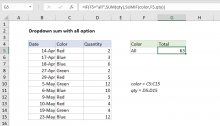


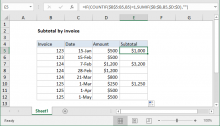

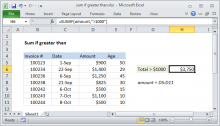

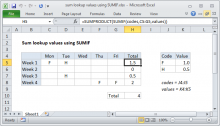
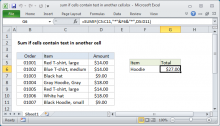

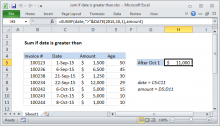
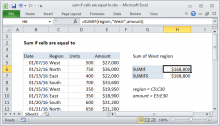
Related videos
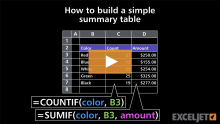


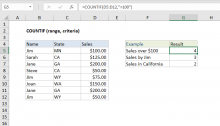
COUNTIF is an excel function to count cells in a range that meet a single condition. COUNTIF can be used to count cells that contain dates, numbers, and text. The criteria used in COUNTIF supports logical.

SUMIFS is a function to sum cells that meet multiple criteria. SUMIFS can be used to sum values when adjacent cells meet criteria based on dates, numbers, and text. SUMIFS supports logical operators (>.

The SUMPRODUCT function multiplies ranges or arrays together and returns the sum of products. This sounds boring, but SUMPRODUCT is an incredibly versatile function that can be used to count and sum like COUNTIFS or SUMIFS, but with more.
Accountingtools
Accounting CPE courses & books
Accountingtools
When you reconcile an account, you are proving that the transactions that sum to the ending account balance for the account are correct. This means you can prove one of the following two assertions:
That the transactions included in a revenue, expense, gain, or loss account belong in that account, and so should not be shifted into an account that more closely matches the nature of the transaction; or
That the transactions included in an asset, liability, or equity account are valid, and so should not be flushed out of the balance sheet by shifting the transactions into accounts associated with the income statement.
Auditors want to see an account reconciliation for larger accounts, though reconciliations should be performed even in the absence of an auditor request, since this is a good accounting practice that leads to more accurate financial statements.
An account reconciliation is usually done for all asset, liability, and equity accounts, since their account balances may continue on for many years. It is less common to reconcile a revenue or expense account, since the account balances are flushed out at the end of each fiscal year. However, this may be done simply to verify that transactions were recorded in the correct account; a reconciliation may reveal that a transaction should be shifted into a different account. Usually, this means moving an expense into a different account.
There are two ways to reconcile an account, which are:
Documentation review. A documentation review is the most common form of account reconciliation, and the one that auditors prefer. Under this method, call up the account detail in the accounting software, and review the appropriateness of each transaction listed in the account. For example, if you are reconciling the trade accounts receivable account, the balance in the account should exactly match the total of the open accounts receivable report.
Analytics review. Under an analytics review, create an estimate of what should be in the account, based on historical activity levels or some other metric. For example, estimate the amount of expected bad debts in the open accounts receivable account, and see if this approximately matches the balance in the allowance for doubtful accounts contra account.
If the account reconciliation reveals that an account balance is not correct, adjust the account balance to match the supporting detail. By doing so, you can always justify the account balances. Also, always retain the reconciliation detail for each account, not only as proof, but also so that it can be used as the starting point for account reconciliations in subsequent periods.
Which savings account is best for a lump sum of money?
What can you do with a lump sum of money?
At some point you might find yourself figuring out what's best to do with a lump sum of money. This could be because you've sold your house or you've had your money in a fixed rate bond which is due to mature soon. Either way, it's important to consider all the options when it comes to what you should do with it.
You can put a lump sum of money in a savings account
Finding a savings account where your money can earn interest is the best place to start. It's always important to compare the annual equivalent rate (AER) when choosing which savings account is best for you. You can also try money saving expert's lump sum savings calculator, to see how much interest saving your money could earn you.
There are four main types of savings accounts, but here are the most popular savings accounts for lump sums of money:
A fixed rate savings account or fixed rate bond
If you're looking to put away your money for a set period of time, a fixed rate savings account or fixed rate bond could be best for you.
Your money is locked away for a certain period and the interest rate is fixed. A fixed rate account usually earns you more interest than an easy access account. Return is guaranteed but withdrawals aren't usually allowed so this doesn't always suit everyone.
The best fixed rate savings account for you will depend on how long you want to leave your money untouched for. The longer you can leave your money, the higher the interest rate you earn will be!
An easy access savings account
An easy access savings account is useful if you're considering moving money into longer-term investments or if you're looking to be more flexible with the money you have. You have the flexibility to withdraw money when you need to.
An easy access savings account usually has a higher interest rate than many current accounts, however a fixed rate savings account will still probably give you the best rate of interest.
If you're a big saver, you might find that putting a lump sum amount into a cash ISA is the most effective way to manage your money.
A cash ISA is a savings account where interest isn't taxed. If you're over the age of 16 in the UK, you can put up to £20,000 in an ISA each year and once it's in it stays tax-free. You can now get tax-free savings through your monzo account too. To find out more, read about getting an ISA with monzo here.
You can also take money out of a fixed rate cash ISA, although there might be penalties which means you lose interest.
You can invest a lump sum of money
Some people decide to invest their money depending on how they feel about risk. Investing into the stock market, whether via a stocks and shares ISA or a pension pot, means that your money can potentially see high growth. But your lump sum investment would also be exposed to any potential downward movements too!
How to make sure your lump sum of money is safe
Your money with one of our savings providers is protected by the financial services compensation scheme (FSCS) for amounts up to £85,000. The money you deposit is protected up to a total of £85,000 by the FSCS. The FSCS apply this limit to each person and to the total amount of any money you have with the provider, whether held through monzo or not.
Please note, this means if you have separate accounts with our savings providers outside of the monzo app, then the deposits held in those accounts will also count towards the limit of £85,000.
Any money in your main monzo account is also protected up to £85,000 by the FSCS, separately to your savings.
Download monzo to start saving for the things that matter. Find out more about saving with monzo here!��
How to transfer money from one bank to another
:strip_icc()/best-ways-to-transfer-money-between-bank-accounts-315466-final-5b3e669ac9e77c00544aca26.png)
Ashley deleon. The balance, 2018
Online banking makes transferring money between bank accounts easier than ever. You can move money from one bank to another electronically using a variety of tools. Each method has pros and cons, but they all get the job done.
Bank-to-bank transfer
If you’re an owner of both bank accounts, a basic bank-to-bank transfer is a good option. You can set up the transfer with the sending or receiving bank, and the funds arrive at the destination after two or three business days. The timing ultimately depends on which banks you use and whether you are moving money internationally or domestically.
Many banks allow you to make free transfers between connected accounts, but it's a good idea to check with both banks, just to be safe.
Before you can complete a transfer, you need to link your accounts. That process can take about a week, so be sure to establish the link before you need to send money.
- Log in to the account you plan to send money from, and look for an option to “add an account,” “add external accounts,” or “link accounts.” you might find those options (or something similar) in your bank’s customer service or transfers menu.
- Provide the other bank’s routing number and your account number at that bank. If you don’t have that information, get those numbers from a check, from that account's online banking account, or from a representative at your bank.
- After submitting that information, you may need to verify that you own the external account. You typically do this by providing a username and password for that account or by confirming small “test” transfers between the two banks.
This method is easiest if both bank accounts are in your name. To transfer funds to somebody else, you may need to use a third-party payment provider (such as paypal) or a wire transfer. ask your bank what the best solution is.
External transfer fees
As online banking has gained in popularity, fees for sending money to external accounts have become less common. As of may 2020, many popular banking institutions offered the service for free. Here’s a small sampling of those institutions:
- Barclays
- Capital one 360
- Chase
- Citi
- Discover bank
- Navy federal credit union
- PNC bank
- Synchrony bank
- Wells fargo
This is not an exhaustive list, as many credit unions and banks also offer similar services for free. Check with local institutions for details.
Apps and online payment tools
If your bank doesn’t offer bank-to-bank transfers or if you need to send money to somebody else, person-to-person (P2P) payment tools may provide what you need. To set up your accounts, link your bank account to the app or service using your checking account and routing numbers the same way you link accounts from separate banks. For example, if using paypal, the funds you send come out of your bank account. Paypal then moves funds to the recipient's paypal account, and the recipient then can spend the money via paypal or transfer it to a bank account.
Numerous options are available:
- Paypal is one of the most popular services. It may be the easiest to use since its popularity means both senders and recipients are likely to have active paypal accounts. There is no charge to transfer money to friends and family if you fund the payment from your bank account. But funding transfers with a debit card, credit card, or paypal credit may result in fees. Businesses may also have to pay paypal to receive payments from customers.
- Most banks offer free or inexpensive P2P transfers through zelle, popmoney, or similar vendors. Those services are often added to your checking account automatically. Look for "personal payments," or something similar, while you're logged in to your account.
- Venmo is a popular tool owned by (and similar to) paypal. Transfers are free unless the source of the funds comes from a credit card. Then, there is a 3% fee.
- Google pay is similar to the services above, and you can link it to (or use it to pay for) google products and services.
Writing old-fashioned checks
Not in any rush to move the money? Sometimes technology is more trouble than it’s worth. Maybe you’ve got a few bucks sitting around in an old bank account, and you just want to move that cash to your new bank. It might not be worth the effort to punch in all the routing and account numbers and sign up for a new app just for that.
If you’ve got checks, writing one to yourself is a simple solution. Just enter your own name down as the payee, and deposit the check into your new account. You can take care of the whole thing without leaving the house if you deposit the check with your mobile device.
If you don’t have a check, ask your bank to print one for you. Even if you’re nowhere near a bank branch, there’s rarely any difficulty getting a check made payable to you (the account owner) and mailed to your home address on file with the bank.
You can use your bank’s online bill payment service to make a payment to yourself.
If you use a credit union that’s part of the shared branching network, you can walk into almost any participating branch in the country and request a check. Moving funds from one credit union to another might be especially easy—and something you can complete in one trip—if they’re both part of the network.
Lump-sum payment
What is a lump-sum payment?
A lump-sum payment is an often large sum that is paid in one single payment instead of broken up into installments. It is also known as a bullet repayment when dealing with a loan. They are sometimes associated with pension plans and other retirement vehicles, such as 401k accounts, where retirees accept a smaller upfront lump-sum payment rather than a larger sum paid out over time. These are often paid out in the event of debentures.
Lump-sum payments are also used to describe a bulk payment to acquire a group of items, such as a company paying one sum for the inventory of another business. Lottery winners will also typically have the option to take a lump-sum payout versus yearly payments.
Key takeaways
- A lump-sum payment is an amount paid all at once, as opposed to an amount that is divvied up and paid in installments.
- A lump-sum payment is not the best choice for every beneficiary; for some, it may make more sense for the funds to be annuitized as periodic payments.
- Based on interest rates, tax situation, and penalties, an annuity may end up having a higher net present value (NPV) than the lump-sum.
Lump-sum payment
The basics of a lump-sum payment
There are pros and cons to accepting lump-sum payments rather than an annuity. The right choice depends on the value of the lump sum versus the payments and one’s financial goals. Annuities provide a degree of financial security, but a retiree in poor health might derive greater benefit from a lump sum payment if they think they will not live long enough to receive the entire benefit. And by receiving an upfront payment, you can pass on the funds to your heirs.
Also, depending on the amount, an upfront payment might enable you to buy a house, a yacht, or another large purchase that you would otherwise not be able to afford with annuities. Similarly, you can invest the money and potentially earn a higher rate of return than the effective rate of return associated with the annual payments. Or, of course, you could lose money on your initial investment.
It is not always best to take the lump-sum payment in lieu of periodic annual payments; if offered the choice, consider taxes, investments, and the net present value, which accounts for the time value of money.
Lump-sums versus annuity payments
To illustrate how lump-sum and annuity payments work, imagine you won $10 million in the lottery. If you took the entire winnings as a lump-sum payment, the entire winnings would be subject to income tax in that year, and you would be in the highest tax bracket.
However, if you choose the annuity option, the payments could come to you over several decades. For example, instead of $10 million of income in one year, your annuity payment might be $300,000 a year. Although the $300,000 would be subject to income tax, it would likely keep you out of the highest state tax brackets. You would also avoid the highest federal income tax bracket of 37% (for 2020 and 20) for single people with incomes greater than $523,600 or $628,300 for married couples filing jointly.
Such tax questions depend on the size of the lottery win, current income tax rates, projected income tax rates, your state of residency when you win, in which state you will live after the win, and investment returns. But if you can earn an annual return of more than 3% to 4%, the lump sum option usually makes more sense with a 30-year annuity.
Another big advantage of taking the money over time is that it provides winners with a "do-over" card. By receiving a check every year, winners have a better chance of managing their money properly, even if things go badly the first year.
How to add numbers in excel:
the SUM function explained
Written by co-founder kasper langmann, microsoft office specialist.
Most people know that excel is a spreadsheet application that allows for entry and storage of data.
Beyond that, most people know that excel can calculate arithmetic operations as well.
In this tutorial, you learn 3 methods to add numbers in excel:
- Adding numbers using a formula
- Adding numbers using the function ‘SUM’
- Using excel’s ‘ autosum ‘ to automatically add numbers
Table of content
*this tutorial is for excel 2019/microsoft 365 (for windows). Got a different version? No problem, you can still follow the exact same steps.
Get your FREE exercise file
Before you start:
Throughout this guide, you need a data set to practice.
I’ve included one for you (for free).
Download the FREE exercise file

How to add numbers with a formula
The basics of adding numbers in excel doesn’t even need a special function.
That said, we will look at just how simple excel does make it with functions.
The main idea when doing any calculation in excel is to begin by typing an equals sign (‘=’).
This is done in the cell where you want to perform the calculation.
So, let’s look at adding two numbers in a cell.

Note that we have simply typed in ‘=1 + 1’ into cell A1.
This is enough to perform the operation and return the sum.
We don’t have to limit the equation to just two terms. We can add more numbers to the equation if we like.

Now you know about the concept of how to add literal number values in a cell.
Let’s look at how easy it is to do the same with cell references.
All we must do is type the cell references or select the cells that contain the values we want to add together.

Notice in this example that we have used the cell references for ‘C2’ and ‘C3’, each of which contain the value ‘2’.
As we would expect, our equation in ‘A2’(‘=C2 + C3’), returns the value ‘4’.
If there were more cells containing values we wanted to add to the equation, we could do the same thing we did with literal values before.
Of course, at some point, adding any more values to the equation becomes inefficient.
But there’s good news! Excel offers a perfect solution that makes adding values far more efficient…the ‘SUM’ function.
So, let's see, what was the most valuable thing of this article: when you open your online profile there are three different menu sections on the left side. Please have a look at the different sections... At sum one account
Contents of the article
- Real forex bonuses
- My sumup profile
- Sales & payouts
- My sumup products
- My profile & more
- Was this article helpful?
- Thanks for letting us know!
- Thanks for letting us know!
- One account
- Getting higher interest rates doesn't have to be...
- More reasons to save this new year
- Credit your salary for additional bonus interest
- How it works
- Spending on eligible UOB credit/debit card
- Crediting your salary into your UOB one account
- Making GIRO debit transaction from your UOB one...
- Interest earning period (2021)
- Met card spend of S$500?
- Credited salary of at least S$2000 via...
- Prevailing interest rate on your...
- Eligible for bonus interest of 0.25%...
- Interest rate you could be enjoying on...
- Benefits
- Up to 10% rebate
- New joint account now available online
- Link mighty FX to your one account
- Convenience of a monthly estatement
- Calculator
- Promotion
- Apply now
- Standard bank sum1 bank account
- Excel SUMIF function
- Related videos
- Accountingtools
- Accountingtools
- Which savings account is best for a lump sum of...
- What can you do with a lump sum of money?
- You can put a lump sum of money in a savings...
- You can invest a lump sum of money
- How to make sure your lump sum of money is safe
- How to transfer money from one bank to another
- Bank-to-bank transfer
- External transfer fees
- Apps and online payment tools
- Writing old-fashioned checks
- Lump-sum payment
- What is a lump-sum payment?
- The basics of a lump-sum payment
- Lump-sums versus annuity payments
- How to add numbers in excel: the...
- Get your FREE exercise file
- How to add numbers with a formula
No comments:
Post a Comment
Note: Only a member of this blog may post a comment.